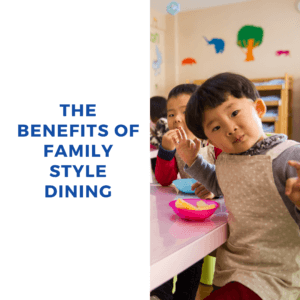Family Style Dining Overview – What it is and the Benefits
Author – Stacey Popowitz
Unfortunately, due to our new COVID19 policies we do not allow the children to self-serve their food. We encourage families to allow children to serve themselves during meal time to practice fine motor skills and portion control, as well as other valuable skills. At SLC we allow children to practice serving themselves as young as 18 months (some children younger depending on their fine motor skills). This does get messy and often times most things don’t make it to the right place, but it is all a part of the process! Have some extra cleaning materials nearby so children can be involved in cleaning up. Having child sized serving tongs and spoons will also be valuable!
Most programs use the family-style dining model to serve meals to the children at their center. Family-style dining is considered a best practice when eating with children of all ages in child care settings. It involves sitting at the same table with young children, in small groups, with the children serving themselves when possible, and eating together with adults while sharing pleasant conversations. People pass food to one another from serving dishes. It is different from cafeteria-style dining, in which children wait in line and are given single servings of food. Being familiar with family-style dining practices can help food service staff plan for and prepare meals that are congruent with this meal style.
There is plenty of research to support the benefits of family-style dining. The Institute of Medicine’s 2011 Early Childhood Obesity Prevention Policies cites family-style dining as a way for child care providers to practice “responsive feeding,” which includes letting children serve themselves and having adults sit and eat with children to model eating, give guidance on serving sizes, and listen to hunger and fullness cues. Children who participate in family-style dining are more attuned to their natural hunger and satiety cues, are more likely to try new foods, and are more likely to make healthier choices when seeing these choices modeled for them.
Participating in family-style dining with young children includes many benefits, it:
- Promotes social skills. Children learn to say, “please” and “thank you.” They learn to ask for what they need, wait patiently, and take turns.
- Prevents behaviors that increase the possibility of arguments, taking someone else’s food, stuffing food into the mouth, potential choking, and playing with food.
- Promotes language and vocabulary development. Children learn the names of new foods, and adults can model complex language around the size, color, texture, taste, and smell of foods. Meals are also a natural time for conversations about interests and ideas.
- Models manners and how to use utensils.
- Establishes warm relationships between children and their peers.
- Promotes hand-eye coordination as children handle dishes and utensils.
- Promotes decision-making and problem-solving as children decide what to eat and how much to eat and how to express their wants and needs.
- Allows children to see adults making healthy choices. This is an excellent opportunity to model these important lifelong behaviors.
Family-style dining has a special look and feel. It should allow caregivers and children to relax, enjoy the meal, and enjoy each other’s company. However, family-style dining does not happen without challenges. Toddlers might spill their drinks, drop their forks, fidget in their seats, and squabble with peers. However, these behaviors are common in early childhood as children gain a greater sense of independence and mastery of their physical skills. You can read more about family-style dining in the attachment below, Benefits and Steps for Family-Style Dining. (https://static.virtuallabschool.org/atmt/food-service/FT.food-service_2.FamilyStyleDining_L1.BenefitsandSteps.pdf)
Information from https://static.virtuallabschool.org/atmt/food-service/FT.food-service_2.FamilyStyleDining_L1.BenefitsandSteps.pdf

“Not by force should the children learn, but through play.” Plato
Social Intelligence (referenced on home page)
“Hey Parents, Leave Those Kids Alone”
Risk is Essential to Childhood
Raising an Emotionally Intelligent ChildLove and Logic
How Can Exercise Improve Learning?
How to Choose the Right Kindergarten School
Brain Rules for Baby by John Medina Book Summary
The Hurried Child
Miseducation- Preschoolers at Risk- Book Review
Caring for Infants with Respect
Stress Management- How to Become Calm
